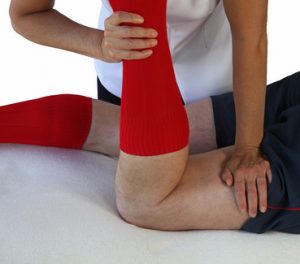8
May, 2017
How to Protect and Strengthen the Knee and Foot
 Knee and foot injuries are common for people of all ages. They tend to occur during day-to-day activities such as walking, climbing stairs and running. In most cases, people tend to ignore the pain and just ‘carry on’, leading to more injury and pain. Rest and medication help reduce pain. However, the residual effects of knee and foot injuries (loss of strength and mobility) are best treated with physical therapy.
Knee and foot injuries are common for people of all ages. They tend to occur during day-to-day activities such as walking, climbing stairs and running. In most cases, people tend to ignore the pain and just ‘carry on’, leading to more injury and pain. Rest and medication help reduce pain. However, the residual effects of knee and foot injuries (loss of strength and mobility) are best treated with physical therapy.
The knee joint is a complex, weight-bearing structure and the ankle, in particular, is protected by ligaments on the inside, outside and the front. Sudden twisting movements can lead to tendon and ligament tears, and in some cases, fractures. Also, a myriad of injuries including strains, sprains, plantar fasciitis, fractures, meniscal tears and ligament tears can lead to impaired mobility and severe pain. These conditions can make it difficult, if not impossible for the individual to walk until the injury heals.
Depending on the severity of the injury, surgery may be required. With or without surgery, physical therapy plays a vital role in recovery from knee and ankle injuries.
Time to Heal
Due to the sensitive, weight-bearing nature of the hip and knee joint, it is critical to allow sufficient time for the healing process. Once healing is complete, physical therapy can begin.
The healing process typically results in
- Weaker muscles
- Tighter ligaments
- Reduced blood flow
- Scar tissue formation
- Joint restrictions
Pain and discomfort is experienced during movement and weight bearing.
Physical therapy will increase strength and mobility to prepare the knee and ankle for active, daily life. Exercises and techniques used by physical therapists include, but are not limited to:
- Therapeutic exercises to strengthen the muscles in the hip, knee, and ankle
- Manual techniques to increase mobility of underlying joints, improve blood circulation and break down scar tissue (when indicated)
- Balance exercises to improve posture and biomechanics while sitting, standing and walking
- Weight control, as needed, to reduce weight bearing stress on the hip, knee and ankle
- Identification of appropriate assistive devices and footwear to facilitate mobility.
Time to Take a Stand!
 Physical therapists use sound, scientifically proven principles of human anatomy, physiology, movement and psychology to help patients lead healthy, pain-free lives.
Physical therapists use sound, scientifically proven principles of human anatomy, physiology, movement and psychology to help patients lead healthy, pain-free lives.
The therapist will conduct an initial evaluation followed by several progress notes to document progress over time. A comprehensive analysis establishes a ‘clinical baseline’ and identifies muscle imbalances, causes of pain and joint alignments. This is the foundation for short and long-term goals designed to help individuals recover completely. In fact, physical therapy can address every aspect of recovery including:
- Gait
- Biomechanical aspects like spine/hip/foot alignments
- Lower back strength
- Pain levels
- Functional capability
As your physical therapist, we will get you back on your feet as soon as possible. Call us today to learn more. You deserve the right kind of care. It’s time to take a stand. Let’s do it together. We are here to help.
